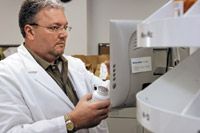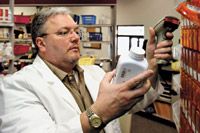Manuel the robot earns his long-term care keep
Figuring Medicare Part D was going to boost his retail script count, Wayne Miller installed a dispensing robot in his pharmacy last December. A month later, he realized that the unit nicknamed Manuel had actually cut days off the time it took technicians to prepackage drugs for long-term care and home care patients.


"I had contemplated installing a robotic dispensing system for a couple of years," Miller said. "I felt one major obstacle was that 50% of our business is long-term care and specialized compliance packages. I didn't see how it would help just with that part of our business. But I decided to bite the bullet. The first week I was grumbling. The second week, I was thinking it was working OK. By the third and fourth weeks, we were saying it's a pretty good thing. It's an application I thought wouldn't work, but it's nice to be proven wrong in a pleasant way."
"We found that the RDS is actually counting the medications and preparing the bottles in the right quantities for the right drugs," said Miller. "We are able to use those products out of the RDS to fill our cards without having to go to the shelf to get it and put it back. To facilitate it, we set up work baskets for each of the sites we service, and as the meds are coming out of the RDS, the techs separate them for the appropriate site. The filling techs just grab the basket and those meds are all ready to be packaged. The RDS has probably cut 25% off the fill time."
Miller's Home Med-Pak compliance program prepackages a seven-day supply of drugs for home delivery. The RDS dispenses a patient's monthly supply that's stored in a hanging bag, will-call system. As the techs fill the weekly packs, they pull the patient's medication bag off the will-call rack. "When a bottle doesn't contain enough drugs for the next seven days, it is put in a basket, and on their down time, the techs run the refills through and re-sort them," said Miller. "It really has helped to reduce the labor time involved in just managing those systems. And it's given us the ability to bill on a prospective basis."
Once Miller decided his daily 400 scripts warranted automation, he did some comparison shopping. His main criteria were the number of drugs a robot holds and its physical bulk. The Parata RDS, which fits 252 dispensing cells into just 12 sq. ft of floor space, won on both counts, he said. He originally figured that it would take 36 months to get a return on his investment, but the unexpected time savings on the LTC side has cut a year off his ROI timeline.
After the RDS took up residence, some staffers embraced it while others hated it. "Once people became familiar with how to use it and what to expect, it became another member of our work team," said Miller. "We affectionately nicknamed it Manuel because while we were getting the interface worked out, we did a lot of manual fills as we began calling it Manuel. So far, he hasn't called in sick or asked for a raise."
Newsletter
Pharmacy practice is always changing. Stay ahead of the curve with the Drug Topics newsletter and get the latest drug information, industry trends, and patient care tips.